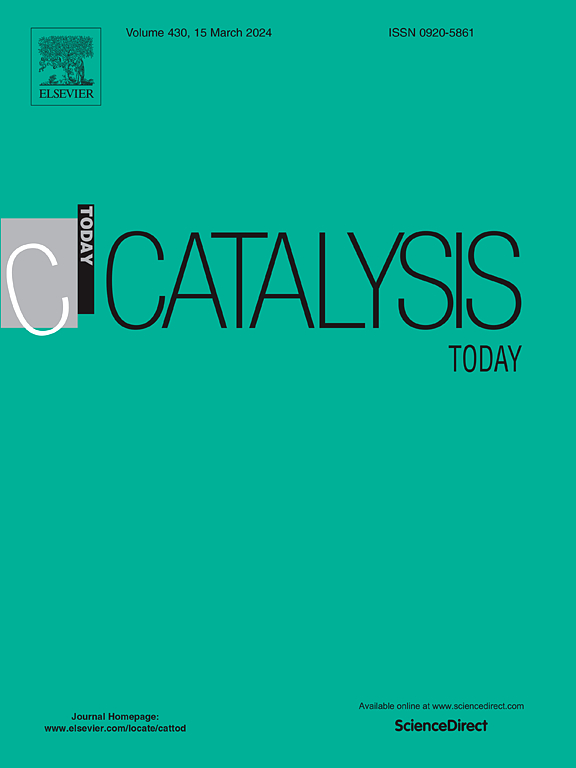芬尼双金属掺杂生物炭对氧进化反应动力学的协同效应:一步式低温热解方法
IF 5.2
2区 化学
Q1 CHEMISTRY, APPLIED
引用次数: 0
摘要
随着氢能源行业的发展,水电解技术在生产绿色氢气方面发挥着至关重要的作用。这项工作的一大挑战在于氧进化反应(OER),该反应的过电位一直很高,导致能源需求增加。本研究开发了一种一步热解技术,将金属支撑的生物质转化为具有更高的结晶度和缺陷位点的 FeNi/NC 催化剂。该工艺无需使用强酸或强碱进行活化,减少了操作步骤和中间产物的处理,降低了技术难度。随着热解温度的升高,生物炭中的金属离子逐渐形成稳定的金属氧化物,从而催化碱性 OER,显著提高催化效率。最重要的是,催化剂中丰富的晶格氧和氧空位在提高 OER 动力学方面发挥了关键作用。值得注意的是,在 750 °C 高温分解的催化剂表现出良好的性能,在 10 mA cm-2 的电流密度下,过电位为 270 mV,优于 RuO2(η10=315 mV)和 IrO2(η10=300 mV)。总之,本研究报告了一种制备高性能 OER 催化剂的方法,以及战略性利用生物质资源在清洁能源技术中的应用。本文章由计算机程序翻译,如有差异,请以英文原文为准。
Synergistic effects of feni bimetal-doped biochar on oxygen evolution reaction kinetics: A one-step, low-temperature pyrolysis approach
As the hydrogen energy sector progresses, water electrolysis technology played a crucial role in producing green hydrogen. A major challenge in this endeavor lied in the oxygen evolution reaction (OER), where the overpotential has consistently been high leading to an increase in the energy demand. This study developed a one-step pyrolysis technique to transform metal-supported biomass into FeNi/NC catalysts having enhanced crystallinity and defect sites. This process without activation step using strong acids or bases reduced the operational procedures and the treatment of intermediate products, which reduced the technical difficulty. As the pyrolysis temperature increases, the metal ions in the biochar gradually formed stable metal oxides, which catalyze the alkaline OER and markedly boosted catalytic efficiency. Crucially, the abundance of lattice oxygen and oxygen vacancies in the catalyst played a key role in enhancing the OER kinetics. Notably, the catalyst pyrolyzed at 750 °C demonstrated good performance, with an overpotential of 270 mV at a concentration of 10 mA cm−2 of the density of current, which was superior to RuO2(η10=315 mV) and IrO2(η10=300 mV). Overall, this study reported an approach for the fabrication of high-performance OER catalysts and the strategic utilization of biomass resources for application in clean energy technologies.
求助全文
通过发布文献求助,成功后即可免费获取论文全文。
去求助
来源期刊

Catalysis Today
化学-工程:化工
CiteScore
11.50
自引率
3.80%
发文量
573
审稿时长
2.9 months
期刊介绍:
Catalysis Today focuses on the rapid publication of original invited papers devoted to currently important topics in catalysis and related subjects. The journal only publishes special issues (Proposing a Catalysis Today Special Issue), each of which is supervised by Guest Editors who recruit individual papers and oversee the peer review process. Catalysis Today offers researchers in the field of catalysis in-depth overviews of topical issues.
Both fundamental and applied aspects of catalysis are covered. Subjects such as catalysis of immobilized organometallic and biocatalytic systems are welcome. Subjects related to catalysis such as experimental techniques, adsorption, process technology, synthesis, in situ characterization, computational, theoretical modeling, imaging and others are included if there is a clear relationship to catalysis.
 求助内容:
求助内容: 应助结果提醒方式:
应助结果提醒方式:


